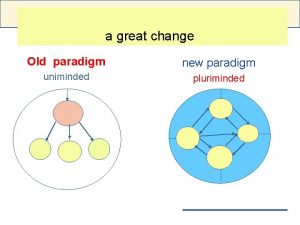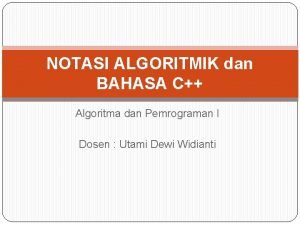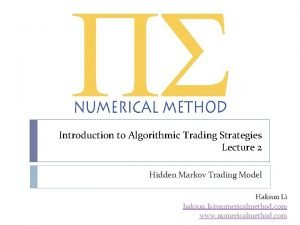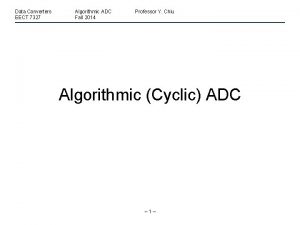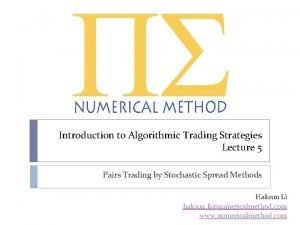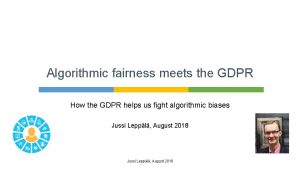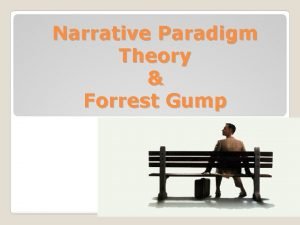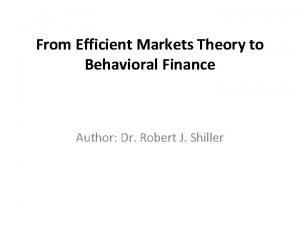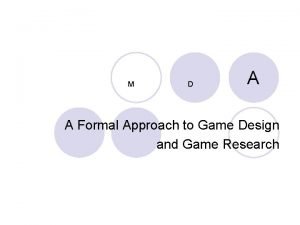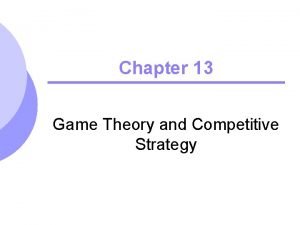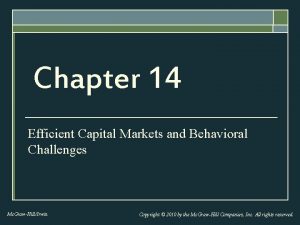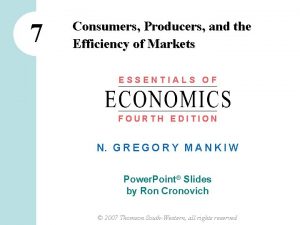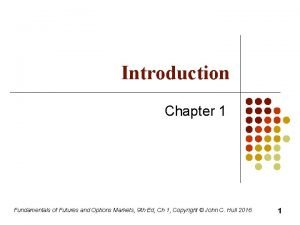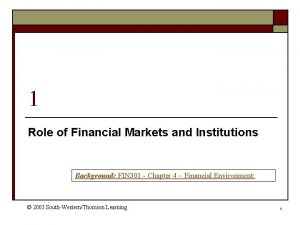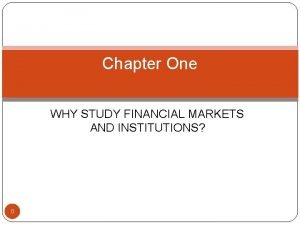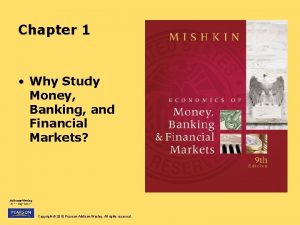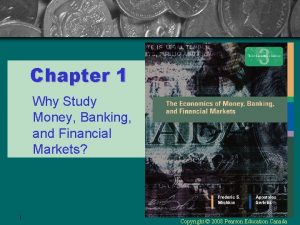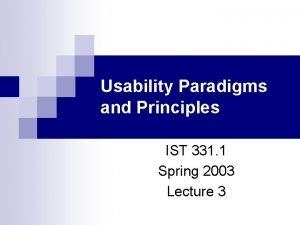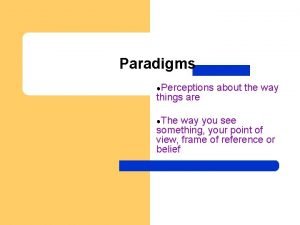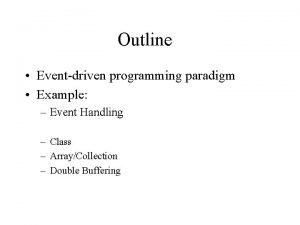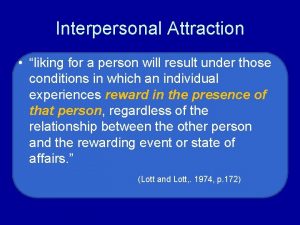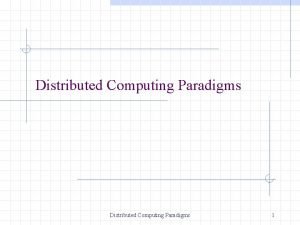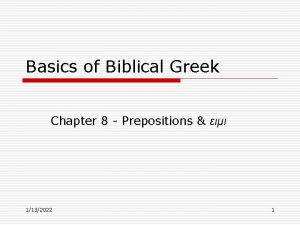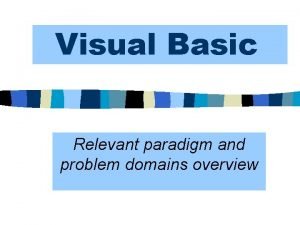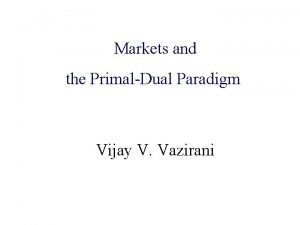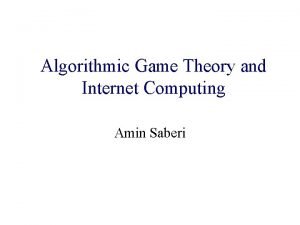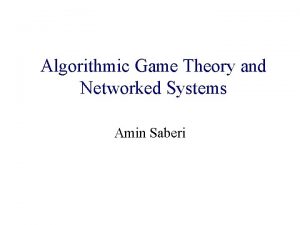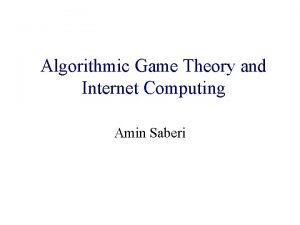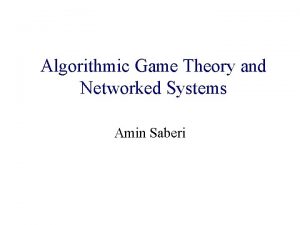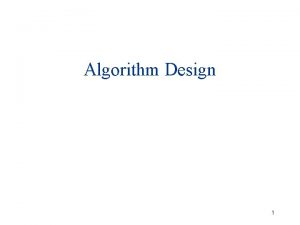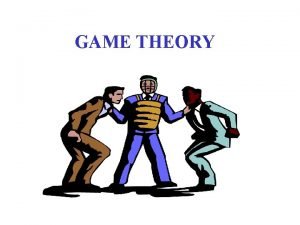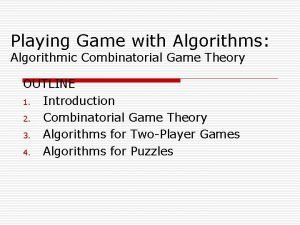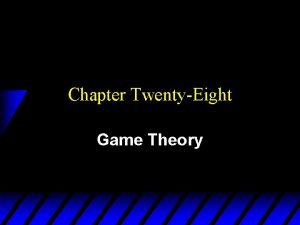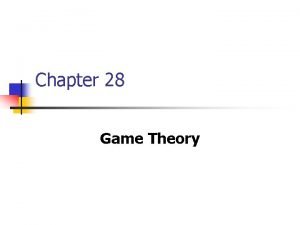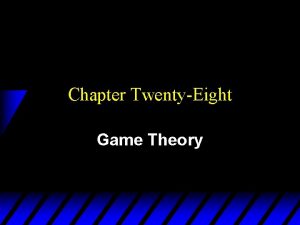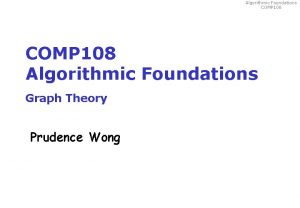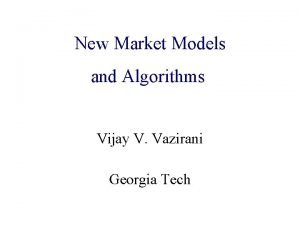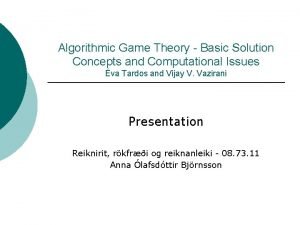Markets and Algorithmic Game Theory the PrimalDual Paradigm






























































































































































- Slides: 158

Markets and Algorithmic Game Theory the Primal-Dual Paradigm and Internet Computing Vijay V. Vazirani

The new face of computing

A paradigm shift in the notion of a “market”!




Historically, the study of markets n has been of central importance, especially in the West

Historically, the study of markets n has been of central importance, especially in the West General Equilibrium Theory Occupied center stage in Mathematical Economics for over a century

General Equilibrium Theory n Also gave us some algorithmic results ¨ Convex programs, whose optimal solutions capture equilibrium allocations, e. g. , Eisenberg & Gale, 1959 Nenakov & Primak, 1983

General Equilibrium Theory n Also gave us some algorithmic results ¨ Convex programs, whose optimal solutions capture equilibrium allocations, e. g. , Eisenberg & Gale, 1959 Nenakov & Primak, 1983 ¨ Scarf, 1973: Algorithms for approximately computing fixed points

Today’s reality n New markets defined by Internet companies, e. g. , ¨ Google ¨ Yahoo! ¨ Amazon ¨ e. Bay n Massive computing power available for running markets in a distributed or centralized manner n A deep theory of algorithms with many powerful techniques

What is needed today? n An inherently-algorithmic theory of markets and market equilibria

What is needed today? n An inherently-algorithmic theory of markets and market equilibria n Beginnings of such a theory, within Algorithmic Game Theory

What is needed today? n An inherently-algorithmic theory of markets and market equilibria n Beginnings of such a theory, within Algorithmic Game Theory n Natural starting point: algorithms for traditional market models

What is needed today? n An inherently-algorithmic theory of markets and market equilibria n Beginnings of such a theory, within Algorithmic Game Theory n Natural starting point: algorithms for traditional market models n New market models emerging!

Theory of algorithms n Interestingly enough, recent study of markets has contributed handsomely to this theory!

A central tenet n Prices are such that demand equals supply, i. e. , equilibrium prices.

A central tenet n Prices are such that demand equals supply, i. e. , equilibrium prices. n Easy if only one good

Supply-demand curves

Irving Fisher, 1891 n Defined a fundamental market model



Utility function utility amount of milk

Utility function utility amount of bread

Utility function utility amount of cheese

Total utility of a bundle of goods = Sum of utilities of individual goods

For given prices,

For given prices, find optimal bundle of goods

Fisher market n Several goods, fixed amount of each good n Several buyers, with individual money and utilities n Find equilibrium prices of goods, i. e. , prices s. t. , ¨ Each buyer gets an optimal bundle ¨ No deficiency or surplus of any good


Combinatorial Algorithm for Linear Case of Fisher’s Model n Devanur, Papadimitriou, Saberi & V. , 2002 Using the primal-dual schema

Primal-Dual Schema n Highly successful algorithm design technique from exact and approximation algorithms

Exact Algorithms for Cornerstone Problems in P: n n n Matching (general graph) Network flow Shortest paths Minimum spanning tree Minimum branching

Approximation Algorithms set cover Steiner tree Steiner network k-MST scheduling. . . facility location k-median multicut feedback vertex set


n No LP’s known for capturing equilibrium allocations for Fisher’s model

n No LP’s known for capturing equilibrium allocations for Fisher’s model n Eisenberg-Gale convex program, 1959

n No LP’s known for capturing equilibrium allocations for Fisher’s model n Eisenberg-Gale convex program, 1959 n DPSV: Extended primal-dual schema to solving a nonlinear convex program

Fisher’s Model n n n buyers, money m(i) for buyer i k goods (unit amount of each good) : utility derived by i on obtaining one unit of j Total utility of i,

n Fisher’s Model n buyers, money m(i) for buyer i k goods (unit amount of each good) : utility derived by i on obtaining one unit of j Total utility of i, n Find market clearing prices n n n

Bang-per-buck n At prices p, buyer i’s most desirable goods, S= n Any goods from S worth m(i) constitute i’s optimal bundle

A convex program n whose optimal solution is equilibrium allocations.

A convex program n whose optimal solution is equilibrium allocations. n Constraints: packing constraints on the xij’s

A convex program n whose optimal solution is equilibrium allocations. n Constraints: packing constraints on the xij’s n Objective fn: max utilities derived.

A convex program n whose optimal solution is equilibrium allocations. n Constraints: packing constraints on the xij’s n Objective fn: max utilities derived. Must satisfy ¨ If utilities of a buyer are scaled by a constant, optimal allocations remain unchanged ¨ If money of buyer b is split among two new buyers, whose utility fns same as b, then union of optimal allocations to new buyers = optimal allocation for b

Money-weighed geometric mean of utilities

Eisenberg-Gale Program, 1959

KKT conditions

n Therefore, buyer i buys from only, i. e. , gets an optimal bundle

n Therefore, buyer i buys from only, i. e. , gets an optimal bundle n Can prove that equilibrium prices are unique!

Idea of algorithm n “primal” variables: allocations n “dual” variables: prices of goods n Approach equilibrium prices from below: ¨ start with very low prices; buyers have surplus money ¨ iteratively keep raising prices and decreasing surplus

Idea of algorithm n Iterations: execute primal & dual improvements Allocations Prices

Will relax KKT conditions n n e(i): money currently spent by i w. r. t. a special allocation surplus money of i

KKT conditions e(i)

Potential function Will show that potential drops by an inverse polynomial factor in each phase (polynomial time).

Potential function Will show that potential drops by an inverse polynomial factor in each phase (polynomial time).

Point of departure KKT conditions are satisfied via a continuous process n Normally: in discrete steps n

Point of departure KKT conditions are satisfied via a continuous process n Normally: in discrete steps n n Open question: strongly polynomial algorithm? ?

An easier question n Given prices p, are they equilibrium prices? n If so, find equilibrium allocations.

An easier question n Given prices p, are they equilibrium prices? n If so, find equilibrium allocations. n Equilibrium prices are unique!

For each buyer, most desirable goods, i. e. m(1) p(1) m(2) p(2) m(3) p(3) m(4) p(4)

Max flow p(1) m(1) p(2) m(2) p(3) m(4) p(4) infinite capacities

Max flow m(1) m(2) m(3) m(4) p(1) p(2) p(3) p(4) p: equilibrium prices iff both cuts saturated

Two important considerations n The price of a good never exceeds its equilibrium price ¨ Invariant: s is a min-cut

Max flow p(1) m(1) p(2) m(2) p(3) m(4) p: low prices

Two important considerations n The price of a good never exceeds its equilibrium price ¨ Invariant: ¨ Identify s is a min-cut tight sets of goods

Two important considerations n The price of a good never exceeds its equilibrium price ¨ Invariant: s is a min-cut ¨ Identify tight sets of goods n Rapid progress is made ¨ Balanced flows

Network N buyers p m bang-per-buck edges goods

Balanced flow in N p m i W. r. t. flow f, surplus(i) = m(i) – f(i, t)

Balanced flow n surplus vector: vector of surpluses w. r. t. f.

Balanced flow n surplus vector: vector of surpluses w. r. t. f. n A flow that minimizes l 2 norm of surplus vector.

Balanced flow n surplus vector: vector of surpluses w. r. t. f. n A flow that minimizes l 2 norm of surplus vector. n Must be a max-flow.

Balanced flow n surplus vector: vector of surpluses w. r. t. f. n A flow that minimizes l 2 norm of surplus vector. n Must be a max-flow. n All balanced flows have same surplus vector.

Balanced flow n surplus vector: vector of surpluses w. r. t. f. n A flow that minimizes l 2 norm of surplus vector. n Makes surpluses as equal as possible.

Property 1 n f: max flow in N. n R: residual graph w. r. t. f. n If surplus (i) < surplus(j) then there is no path from i to j in R.

Property 1 R: i j surplus(i) < surplus(j)

Property 1 R: i j surplus(i) < surplus(j)

Property 1 R: i j Circulation gives a more balanced flow.

Property 1 n Theorem: A max-flow is balanced iff it satisfies Property 1.

Will relax KKT conditions n n e(i): money currently spent by i w. r. t. a special allocation surplus money of i

Will relax KKT conditions n n e(i): money currently spent by i w. r. t. a balanced flow in N surplus money of i

Pieces fit just right! Balanced flows Tight sets Invariant Bang-per-buck edges

Another point of departure n Complementary slackness conditions: involve primal or dual variables, not both. n KKT conditions: involve primal and dual variables simultaneously.

KKT conditions

KKT conditions

Primal-dual algorithms so far n Raise dual variables greedily. (Lot of effort spent on designing more sophisticated dual processes. )

Primal-dual algorithms so far n Raise dual variables greedily. (Lot of effort spent on designing more sophisticated dual processes. ) ¨ Only exception: Edmonds, 1965: algorithm for weight matching.

Primal-dual algorithms so far n Raise dual variables greedily. (Lot of effort spent on designing more sophisticated dual processes. ) ¨ Only n exception: Edmonds, 1965: algorithm for weight matching. Otherwise primal objects go tight and loose. Difficult to account for these reversals in the running time.

Our algorithm n Dual variables (prices) are raised greedily n Yet, primal objects go tight and loose ¨ Because of enhanced KKT conditions

Deficiencies of linear utility functions n Typically, a buyer spends all her money on a single good n Do not model the fact that buyers get satiated with goods

Concave utility function utility amount of j

Concave utility functions n Do not satisfy weak gross substitutability

Concave utility functions n Do not satisfy weak gross substitutability ¨ w. g. s. = Raising the price of one good cannot lead to a decrease in demand of another good.

Concave utility functions n Do not satisfy weak gross substitutability ¨ w. g. s. n = Raising the price of one good cannot lead to a decrease in demand of another good. Open problem: find polynomial time algorithm!

Piecewise linear, concave utility amount of j

PTAS for concave function utility amount of j

Piecewise linear concave utility n Does not satisfy weak gross substitutability

Piecewise linear, concave utility amount of j

Differentiate rate = utility/unit amount of j rate amount of j

rate = utility/unit amount of j rate amount of j money spent on j

Spending constraint utility function rate = utility/unit amount of j rate $20 $40 $60 money spent on j

Spending constraint utility function n Happiness derived is not a function of allocation only but also of amount of money spent.

Extend model: assume buyers have utility for money rate $20 $40 $100


Theorem: Polynomial time algorithm for computing equilibrium prices and allocations for Fisher’s model with spending constraint utilities. Furthermore, equilibrium prices are unique.

Satisfies weak gross substitutability!

Old pieces become more complex + there are new pieces

But they still fit just right!

Don Patinkin, 1922 -1995 n Considered utility functions that are a function of allocations and prices.

An unexpected fallout!!

An unexpected fallout!! n A new kind of utility function ¨ Happiness derived is not a function of allocation only but also of amount of money spent.

An unexpected fallout!! n A new kind of utility function ¨ Happiness derived is not a function of allocation only but also of amount of money spent. n Has applications in Google’s Ad. Words Market!

A digression

Ad. Words Market n Created by search engine companies ¨ Google ¨ Yahoo! ¨ MSN n Multi-billion dollar market – and still growing! n Totally revolutionized advertising, especially by small companies.

The view 5 years ago: Relevant Search Results


Business world’s view now : (as Advertisement companies)

So how does this work? Bids for different keywords Daily Budgets

Ad. Words Allocation Problem Lawyers. Rus. com asbestos Search Engine Sue. com Search results Ads Tax. Helper. com Whose ad to put How to maximize revenue?

Ad. Words Problem n Mehta, Saberi, Vazirani & Vazirani, 2005: 1 -1/e algorithm, assuming budgets>>bids

Ad. Words Problem n Mehta, Saberi, Vazirani & Vazirani, 2005: 1 -1/e algorithm, assuming budgets>>bids Optimal!

Ad. Words Problem n Mehta, Saberi, Vazirani & Vazirani, 2005: 1 -1/e algorithm, assuming budgets>>bids Optimal!

Spending constraint utilities Ad. Words Market

Ad. Words market n Assume that Google will determine equilibrium price/click for keywords

Ad. Words market n Assume that Google will determine equilibrium price/click for keywords n How should advertisers specify their utility functions?

Choice of utility function n Expressive enough that advertisers get close to their ‘‘optimal’’ allocations

Choice of utility function n Expressive enough that advertisers get close to their ‘‘optimal’’ allocations n Efficiently computable

Choice of utility function n Expressive enough that advertisers get close to their ‘‘optimal’’ allocations n Efficiently computable n Easy to specify utilities

n linear utility function: a business will typically get only one type of query throughout the day!

n linear utility function: a business will typically get only one type of query throughout the day! n concave utility function: no efficient algorithm known!

n linear utility function: a business will typically get only one type of query throughout the day! n concave utility function: no efficient algorithm known! ¨ Difficult for advertisers to define concave functions

Easier for a buyer n To say what are “good” allocations, for a range of prices, rather than how happy she is with a given bundle.

Online shoe business n Interested in two keywords: men’s clog ¨ women’s clog ¨ n Advertising budget: $100/day n Expected profit: ¨ men’s clog: ¨ women’s clog: $2/click $4/click

Considerations for long-term profit n Try to sell both goods - not just the most profitable good n Must have a presence in the market, even if it entails a small loss

n If both are profitable, ¨ better keyword is at least twice as profitable ($100, $0) ¨ otherwise ($60, $40) n If neither is profitable n If only one is profitable, very profitable (at least $2/$) ¨ otherwise ¨ ($20, $0) ($100, $0) ($60, $0)

men’s clog rate = utility/click rate 2 1 $60 $100

women’s clog rate = utility/click 4 rate 2 $60 $100

money rate = utility/$ rate 1 0 $80 $100

Ad. Words market n Suppose Google stays with auctions but allows advertisers to specify bids in the spending constraint model

Ad. Words market n Suppose Google stays with auctions but allows advertisers to specify bids in the spending constraint model ¨ expressivity!

Ad. Words market n Suppose Google stays with auctions but allows advertisers to specify bids in the spending constraint model ¨ expressivity! n Good online algorithm for maximizing Google’s revenues?

n Goel & Mehta, 2006: A small modification to the MSVV algorithm achieves 1 – 1/e competitive ratio!

Open Is there a convex program that captures equilibrium allocations for spending constraint utilities?

Spending constraint utilities satisfy n Equilibrium exists (under mild conditions) n Equilibrium utilities and prices are unique n Rational n With small denominators

Linear utilities also satisfy n Equilibrium exists (under mild conditions) n Equilibrium utilities and prices are unique n Rational n With small denominators

Proof follows from Eisenberg-Gale Convex Program, 1959

For spending constraint utilities, proof follows from algorithm, and not a convex program!

Open Is there an LP whose optimal solutions capture equilibrium allocations for Fisher’s linear case?

Open Use spending constraint algorithm to solve piecewise linear, concave utilities

Piece-wise linear, concave utility amount of j

Differentiate rate = utility/unit amount of j rate amount of j

n n Start with arbitrary prices, adding up to total money of buyers.

rate = utility/unit amount of j rate money spent on j

n Start with arbitrary prices, adding up to total money of buyers. n n Run algorithm on these utilities to get new prices.

n Start with arbitrary prices, adding up to total money of buyers. n n Run algorithm on these utilities to get new prices.

n Start with arbitrary prices, adding up to total money of buyers. n n Run algorithm on these utilities to get new prices. n Fixed points of this procedure are equilibrium prices for piecewise linear, concave utilities!

Algorithms & Game Theory common origins von Neumann, 1928: minimax theorem for 2 -person zero sum games n von Neumann & Morgenstern, 1944: Games and Economic Behavior n von Neumann, 1946: Report on EDVAC n n Dantzig, Gale, Kuhn, Scarf, Tucker …

 Old paradigm
Old paradigm Algorithmic graph theory and perfect graphs
Algorithmic graph theory and perfect graphs Pirate game grid
Pirate game grid Game lab game theory
Game lab game theory Liar game game theory
Liar game game theory Liar game game theory
Liar game game theory Game theory and graph theory
Game theory and graph theory Algorithmic trading singapore
Algorithmic trading singapore Algorithmic state machine examples
Algorithmic state machine examples Abstraction computer science gcse
Abstraction computer science gcse Algorithmic nuggets in content delivery
Algorithmic nuggets in content delivery Algorithmic cost modelling
Algorithmic cost modelling Notasi algoritmik
Notasi algoritmik Introduction to algorithmic trading strategies
Introduction to algorithmic trading strategies Introduction to algorithmic trading strategies
Introduction to algorithmic trading strategies Algorithm analysis examples
Algorithm analysis examples Low frequency algorithmic trading
Low frequency algorithmic trading Introduction to algorithmic trading strategies
Introduction to algorithmic trading strategies Algorithmic adc
Algorithmic adc Ekkehart boehmer
Ekkehart boehmer Algorithmic event correlation
Algorithmic event correlation Asm
Asm Gdpr algorithmic bias
Gdpr algorithmic bias Forrest gump narration
Forrest gump narration From efficient markets theory to behavioral finance
From efficient markets theory to behavioral finance Efficient market hypothesis
Efficient market hypothesis A formal approach to game design and game research
A formal approach to game design and game research Paradigm and principles
Paradigm and principles Paradigmatic and syntagmatic analysis
Paradigmatic and syntagmatic analysis Hát kết hợp bộ gõ cơ thể
Hát kết hợp bộ gõ cơ thể Frameset trong html5
Frameset trong html5 Bổ thể
Bổ thể Tỉ lệ cơ thể trẻ em
Tỉ lệ cơ thể trẻ em Gấu đi như thế nào
Gấu đi như thế nào Chụp phim tư thế worms-breton
Chụp phim tư thế worms-breton Alleluia hat len nguoi oi
Alleluia hat len nguoi oi Các môn thể thao bắt đầu bằng tiếng đua
Các môn thể thao bắt đầu bằng tiếng đua Thế nào là hệ số cao nhất
Thế nào là hệ số cao nhất Các châu lục và đại dương trên thế giới
Các châu lục và đại dương trên thế giới Công của trọng lực
Công của trọng lực Trời xanh đây là của chúng ta thể thơ
Trời xanh đây là của chúng ta thể thơ Cách giải mật thư tọa độ
Cách giải mật thư tọa độ Phép trừ bù
Phép trừ bù Phản ứng thế ankan
Phản ứng thế ankan Các châu lục và đại dương trên thế giới
Các châu lục và đại dương trên thế giới Thể thơ truyền thống
Thể thơ truyền thống Quá trình desamine hóa có thể tạo ra
Quá trình desamine hóa có thể tạo ra Một số thể thơ truyền thống
Một số thể thơ truyền thống Cái miệng nó xinh thế
Cái miệng nó xinh thế Vẽ hình chiếu vuông góc của vật thể sau
Vẽ hình chiếu vuông góc của vật thể sau Nguyên nhân của sự mỏi cơ sinh 8
Nguyên nhân của sự mỏi cơ sinh 8 đặc điểm cơ thể của người tối cổ
đặc điểm cơ thể của người tối cổ Thế nào là giọng cùng tên? *
Thế nào là giọng cùng tên? * Vẽ hình chiếu đứng bằng cạnh của vật thể
Vẽ hình chiếu đứng bằng cạnh của vật thể Vẽ hình chiếu vuông góc của vật thể sau
Vẽ hình chiếu vuông góc của vật thể sau Thẻ vin
Thẻ vin đại từ thay thế
đại từ thay thế điện thế nghỉ
điện thế nghỉ Tư thế ngồi viết
Tư thế ngồi viết Diễn thế sinh thái là
Diễn thế sinh thái là Dot
Dot Bảng số nguyên tố lớn hơn 1000
Bảng số nguyên tố lớn hơn 1000 Tư thế ngồi viết
Tư thế ngồi viết Lời thề hippocrates
Lời thề hippocrates Thiếu nhi thế giới liên hoan
Thiếu nhi thế giới liên hoan ưu thế lai là gì
ưu thế lai là gì Sự nuôi và dạy con của hươu
Sự nuôi và dạy con của hươu Sự nuôi và dạy con của hươu
Sự nuôi và dạy con của hươu Hệ hô hấp
Hệ hô hấp Từ ngữ thể hiện lòng nhân hậu
Từ ngữ thể hiện lòng nhân hậu Thế nào là mạng điện lắp đặt kiểu nổi
Thế nào là mạng điện lắp đặt kiểu nổi Farming game instructions
Farming game instructions Maximin and minimax principle
Maximin and minimax principle Significance of game theory
Significance of game theory Game theory in wireless and communication networks
Game theory in wireless and communication networks Chapter 13 game theory and competitive strategy
Chapter 13 game theory and competitive strategy Why study financial markets and institutions?
Why study financial markets and institutions? Financial markets and institutions jeff madura ppt
Financial markets and institutions jeff madura ppt Consumers producers and the efficiency of markets
Consumers producers and the efficiency of markets Historic tax credits 101
Historic tax credits 101 Characteristic of consumer behaviour
Characteristic of consumer behaviour Chapter 9 expanding markets and moving west
Chapter 9 expanding markets and moving west Business markets and business buyer behavior
Business markets and business buyer behavior Analyzing consumer and business markets
Analyzing consumer and business markets Product-market boundaries and structure
Product-market boundaries and structure Buyer behaviour
Buyer behaviour Financial institutions and markets lecture notes ppt
Financial institutions and markets lecture notes ppt Urban economics and real estate markets
Urban economics and real estate markets Markets management and the economy dartmouth
Markets management and the economy dartmouth Mutual fund flows and performance in rational markets
Mutual fund flows and performance in rational markets Types of financial intermediaries
Types of financial intermediaries Consumer markets and consumer buyer behavior
Consumer markets and consumer buyer behavior Similarities between consumers and organizational markets
Similarities between consumers and organizational markets Target market and channel design strategy
Target market and channel design strategy Chapter 5 consumer markets and buyer behavior
Chapter 5 consumer markets and buyer behavior International financial markets and instruments
International financial markets and instruments Efficient capital markets and behavioral challenges
Efficient capital markets and behavioral challenges Consumers producers and the efficiency of markets
Consumers producers and the efficiency of markets Pave smart
Pave smart Capital markets and financial intermediation
Capital markets and financial intermediation Fundamentals of futures and options markets
Fundamentals of futures and options markets How do primary and secondary financial markets differ
How do primary and secondary financial markets differ Efficient capital allocation
Efficient capital allocation Digital markets and digital goods
Digital markets and digital goods Change in supply vs change in quantity supplied
Change in supply vs change in quantity supplied Types of exchange rate
Types of exchange rate Equity markets and stock valuation
Equity markets and stock valuation Analyzing consumer markets and buyer behavior
Analyzing consumer markets and buyer behavior Basic flow of funds through the financial system
Basic flow of funds through the financial system Madura j. financial markets and institutions
Madura j. financial markets and institutions Strategies for mature and declining markets
Strategies for mature and declining markets Pilbeam k. finance and financial markets
Pilbeam k. finance and financial markets Pilbeam finance and financial markets
Pilbeam finance and financial markets Role of financial markets and institutions
Role of financial markets and institutions Expanding markets and moving west
Expanding markets and moving west Madura j. financial markets and institutions
Madura j. financial markets and institutions Article 20-c food processing license
Article 20-c food processing license Finance for normal people: how investors and markets behave
Finance for normal people: how investors and markets behave Chapter 9 expanding markets and moving west
Chapter 9 expanding markets and moving west Why study financial markets and institutions
Why study financial markets and institutions Chapter 9 expanding markets and moving west
Chapter 9 expanding markets and moving west Chapter 7 consumers producers and the efficiency of markets
Chapter 7 consumers producers and the efficiency of markets Chapter 6 consumers savers and investors
Chapter 6 consumers savers and investors Difference between consumer market and business market
Difference between consumer market and business market Why study money banking and financial markets
Why study money banking and financial markets Why study money banking and financial markets
Why study money banking and financial markets Analyzing consumer markets
Analyzing consumer markets Analyzing consumer market
Analyzing consumer market Analyzing consumer market
Analyzing consumer market World english paradigm
World english paradigm Fast friends paradigm
Fast friends paradigm Usability paradigm
Usability paradigm Mertens transformative paradigm
Mertens transformative paradigm The whole person paradigm
The whole person paradigm What are variables in research methodology
What are variables in research methodology Paf paradigm
Paf paradigm 7 habits paradigm
7 habits paradigm Quality improvement paradigm
Quality improvement paradigm Enemy centered paradigm
Enemy centered paradigm Paradigm shift example
Paradigm shift example Paradigm shift from women studies to gender studies
Paradigm shift from women studies to gender studies Paradigm blindness examples
Paradigm blindness examples Event driven programming paradigm
Event driven programming paradigm Narrative paradigm
Narrative paradigm Ipo research paradigm
Ipo research paradigm Paradigm definition
Paradigm definition Bogus stranger paradigma
Bogus stranger paradigma Microprocessor in hci
Microprocessor in hci Research instrument in experimental research
Research instrument in experimental research Cloud computing paradigm
Cloud computing paradigm Distributed computation paradigms
Distributed computation paradigms Channel design marketing
Channel design marketing Current paradigms in psychopathology
Current paradigms in psychopathology All resources are tightly coupled in computing paradigm of
All resources are tightly coupled in computing paradigm of Boomerang paradigm
Boomerang paradigm Eimi paradigm
Eimi paradigm Paradigm of the channel design decision example
Paradigm of the channel design decision example Functionalist paradigm
Functionalist paradigm Visual basic paradigm
Visual basic paradigm
